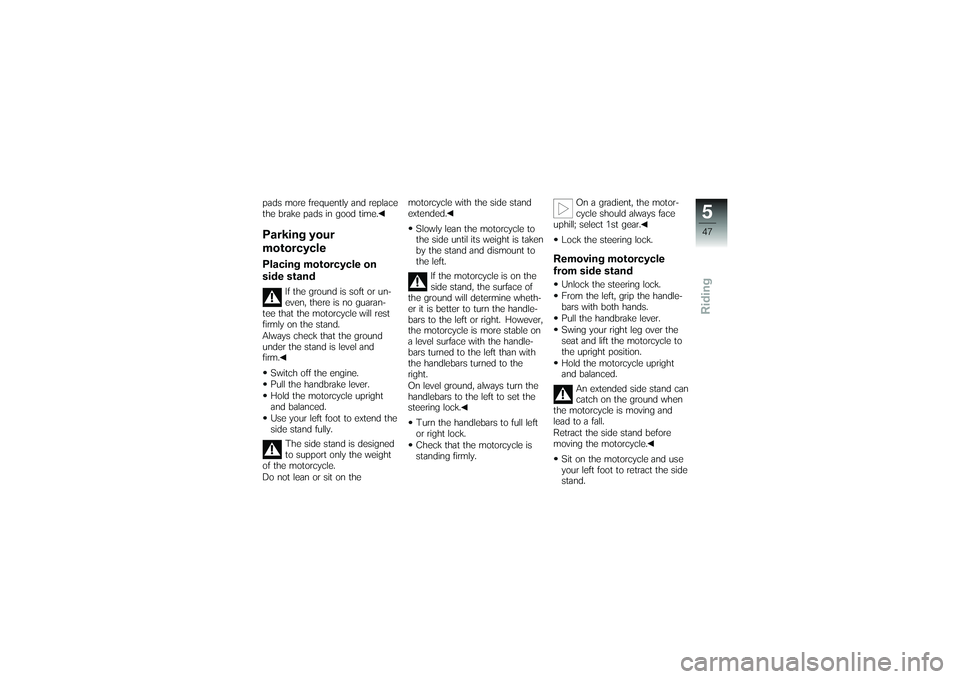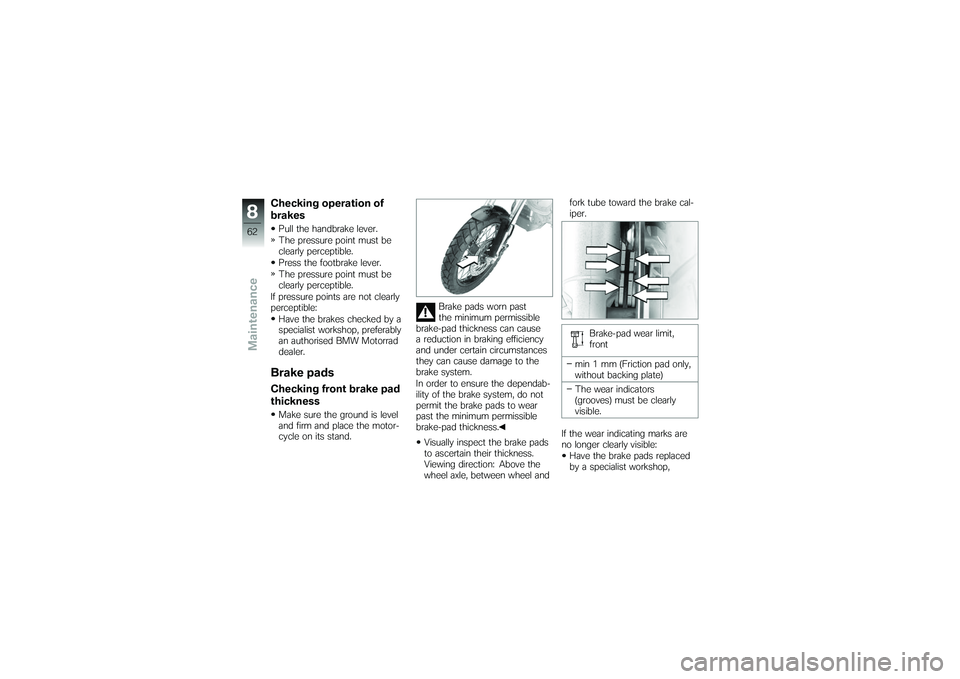Page 49 of 126

pads more frequently and replace
the brake pads in good time.Parking your
motorcyclePlacing motorcycle on
side stand
If the ground is soft or un-
even, there is no guaran-
tee that the motorcycle will rest
firmly on the stand.
Always check that the ground
under the stand is level and
firm.
Switch off the engine.
Pull the handbrake lever.
Hold the motorcycle upright
and balanced.
Use your left foot to extend the
side stand fully. The side stand is designed
to support only the weight
of the motorcycle.
Do not lean or sit on the motorcycle with the side stand
extended.
Slowly lean the motorcycle to
the side until its weight is taken
by the stand and dismount to
the left. If the motorcycle is on the
side stand, the surface of
the ground will determine wheth-
er it is better to turn the handle-
bars to the left or right. However,
the motorcycle is more stable on
a level surface with the handle-
bars turned to the left than with
the handlebars turned to the
right.
On level ground, always turn the
handlebars to the left to set the
steering lock.
Turn the handlebars to full left
or right lock.
Check that the motorcycle is
standing firmly. On a gradient, the motor-
cycle should always face
uphill; select 1st gear.
Lock the steering lock.
Removing motorcycle
from side standUnlock the steering lock.
From the left, grip the handle-
bars with both hands.
Pull the handbrake lever.
Swing your right leg over the
seat and lift the motorcycle to
the upright position.
Hold the motorcycle upright
and balanced. An extended side stand can
catch on the ground when
the motorcycle is moving and
lead to a fall.
Retract the side stand before
moving the motorcycle.
Sit on the motorcycle and use
your left foot to retract the side
stand.
547zRiding
Page 64 of 126

Checking operation of
brakesPull the handbrake lever.
The pressure point must be
clearly perceptible.
Press the footbrake lever.
The pressure point must be
clearly perceptible.
If pressure points are not clearly
perceptible: Have the brakes checked by a
specialist workshop, preferably
an authorised BMW Motorrad
dealer.Brake padsChecking front brake pad
thicknessMake sure the ground is level
and firm and place the motor-
cycle on its stand. Brake pads worn past
the minimum permissible
brake-pad thickness can cause
a reduction in braking efficiency
and under certain circumstances
they can cause damage to the
brake system.
In order to ensure the dependab-
ility of the brake system, do not
permit the brake pads to wear
past the minimum permissible
brake-pad thickness.
Visually inspect the brake pads
to ascertain their thickness.
Viewing direction: Above the
wheel axle, between wheel and fork tube toward the brake cal-
iper.
Brake-pad wear limit,
front
min 1 mm (Friction pad only,
without backing plate)
The wear indicators
(grooves) must be clearly
visible.
If the wear indicating marks are
no longer clearly visible: Have the brake pads replaced
by a specialist workshop,
862zMaintenance
Page 73 of 126
Slacken left axle clamping
screws2.
Remove axle screw 3.
Slacken right axle clamping
screws 4. Use a screwdriver to remove
axle
5.
Do not remove the grease from
the axle.
Hold left slider tube 6and turn
the front wheel left to push the
brake pads apart.
Once the calipers have
been removed, there is
a risk of the brake pads being
pressed together to the extent
that they cannot be slipped back
over the brake disc on reas-
sembly.
Do not operate the handbrake lever when the brake calipers
have been removed.
Roll the front wheel clear of the
forks.
Remove spacer sleeve 7.
871zMaintenance